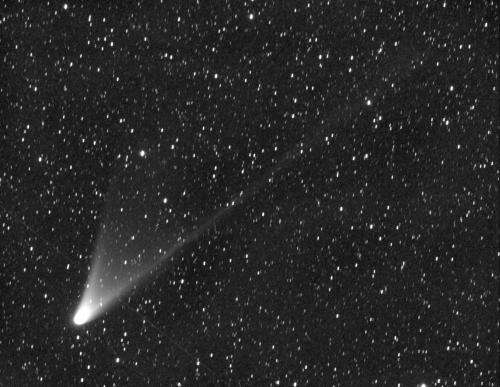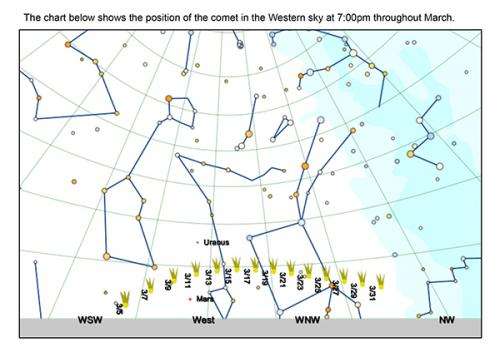Comet Pan-STARRS will be visible in northern hemisphere in March

(Phys.org)—Comet Pan-STARRS C/2011 L4, discovered by the Pan-STARRS 1 telescope on Haleakala in June 2011, is expected to become visible to the naked eye in the Northern Hemisphere in March.
The comet is currently visible in the Southern Hemisphere.
From about March 7, it will appear above the horizon. To see it, you will need an unobstructed, cloudless view of the western horizon. It is best to pick a dark spot, away from streetlights.
Look in the direction of the Sunset just after the Sun has gone down. The comet will be just above the horizon.
The twilight sky will make the comet much harder to see than if it were high up in a dark sky, and moonlight will interfere with viewing the comet after March 13.
To see the comet's tails, you may need a pair of binoculars.

Although the brightness of comets is notoriously difficult to predict ahead of time, scientists expect this comet will have a brightness similar to that of the stars in the bowl of the Big Dipper or Orion's belt (magnitude 2 to 3).
March 13 may be the best time to take an interesting picture of the comet because on that evening, it will appear just below the thin crescent Moon.
By the end of March, the comet will no longer be visible in the evening sky, but if you get up early, you may be able to see it in the eastern sky just before sunrise. However, by then the comet will be farther from both the Sun and Earth, and will therefore be fainter.
Comets are balls of ice and dust. As they approach the Sun, they heat up, and the ice begins to sublime—to change from ice into a gas. When that happens, they develop a coma, a large envelope of gas and dust that surrounds the solid nucleus, and two tails, a dust tail and an ion tail that consists of gas molecules ionized by sunlight. Each of these tails may be over a million miles long. It is because of the coma and tails that they become visible to the naked eye, sometimes spectacularly so.
Some comets, including Comet Pan-STARRS, follow an orbit that begins in the very outer reaches of the solar system. As they pass by the planets, they receive a gravitational "kick" that propels them out of the solar system. Their sole visits to the inner solar system are therefore our only chance to see them.
Others, like Halley's comet, have elliptical orbits, and return to the inner solar system again and again, although their orbits are sometimes so large that it takes hundreds or thousands of years for them to return.
Provided by University of Hawaii at Manoa





















